Qantas Airways Business Strategy Analysis
VerifiedAdded on 2023/06/04
|15
|4458
|397
AI Summary
This report analyzes the business strategies of Qantas Airways, including industry analysis using Porter's five forces and PESTEL analysis, critical success factors, SWOT analysis, and past and current business strategies. It also recommends future business strategies for Qantas to become a strong competitor.
Contribute Materials
Your contribution can guide someone’s learning journey. Share your
documents today.
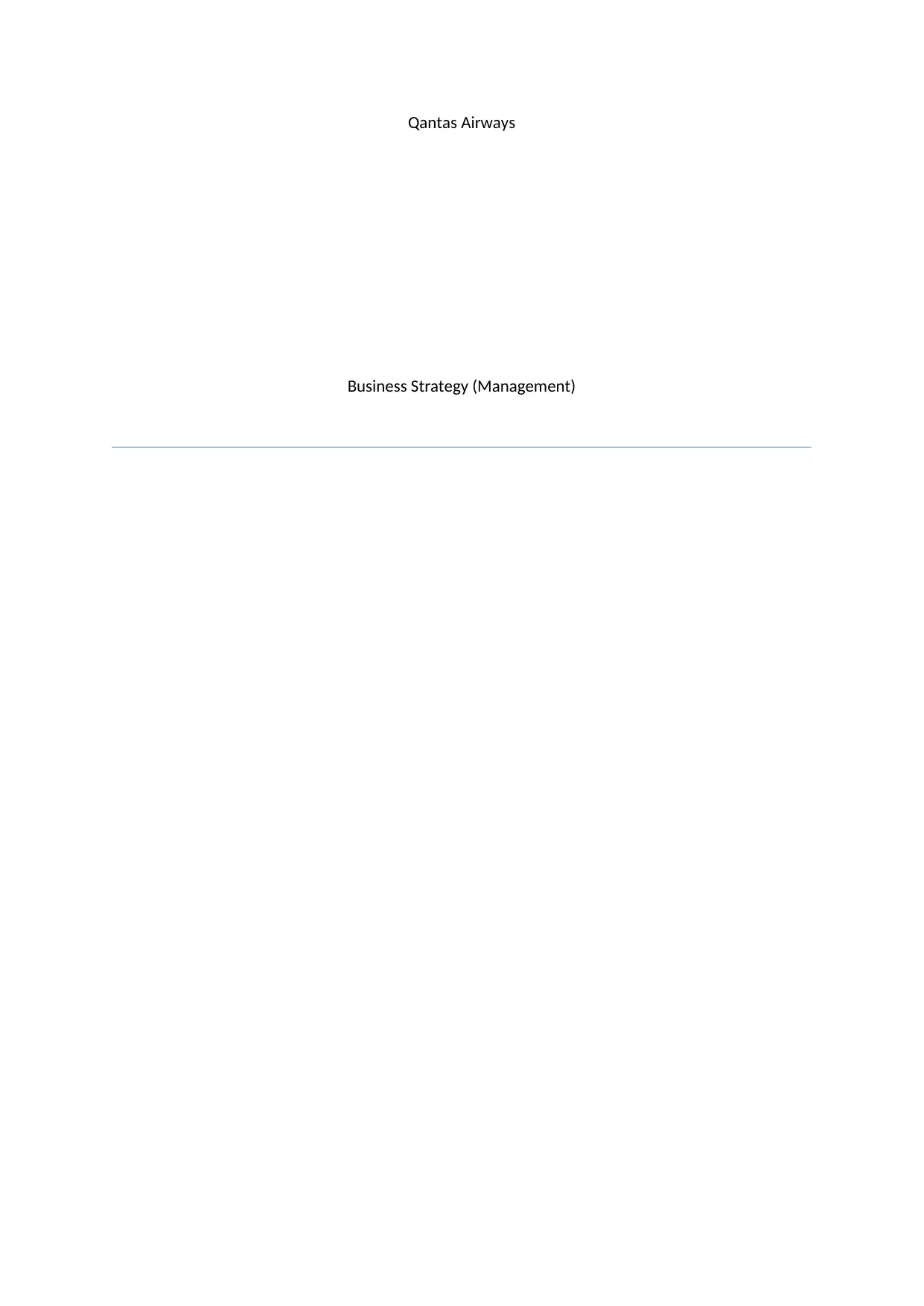
Qantas Airways
Business Strategy (Management)
Business Strategy (Management)
Secure Best Marks with AI Grader
Need help grading? Try our AI Grader for instant feedback on your assignments.
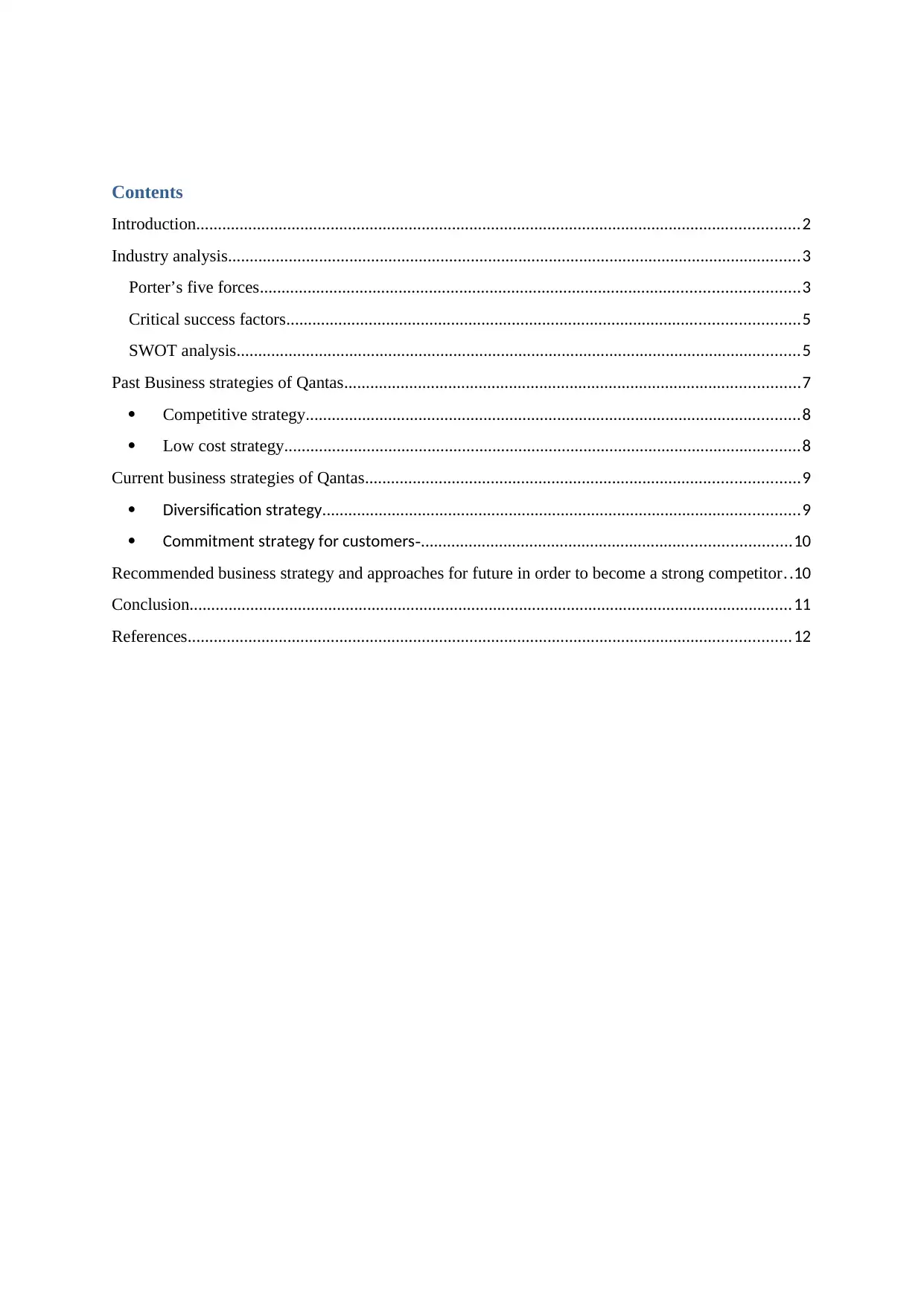
Contents
Introduction...........................................................................................................................................2
Industry analysis....................................................................................................................................3
Porter’s five forces............................................................................................................................3
Critical success factors......................................................................................................................5
SWOT analysis..................................................................................................................................5
Past Business strategies of Qantas.........................................................................................................7
Competitive strategy..................................................................................................................8
Low cost strategy.......................................................................................................................8
Current business strategies of Qantas....................................................................................................9
Diversification strategy..............................................................................................................9
Commitment strategy for customers-.....................................................................................10
Recommended business strategy and approaches for future in order to become a strong competitor. .10
Conclusion...........................................................................................................................................11
References...........................................................................................................................................12
Introduction...........................................................................................................................................2
Industry analysis....................................................................................................................................3
Porter’s five forces............................................................................................................................3
Critical success factors......................................................................................................................5
SWOT analysis..................................................................................................................................5
Past Business strategies of Qantas.........................................................................................................7
Competitive strategy..................................................................................................................8
Low cost strategy.......................................................................................................................8
Current business strategies of Qantas....................................................................................................9
Diversification strategy..............................................................................................................9
Commitment strategy for customers-.....................................................................................10
Recommended business strategy and approaches for future in order to become a strong competitor. .10
Conclusion...........................................................................................................................................11
References...........................................................................................................................................12

Introduction
Qantas is biggest airline of Australia that connects over 1000 destinations all around the
globe. In 1920, its first aircraft launched. After its first launch, it is continuously groaning as
a leading branch in the aviation industry. It provides employment opportunities to more than
30,000 people from different countries in which it operates. The vision of Qantas airlines is to
provide low fare airlines and better Jet star facilities to the middle class people. It has
established itself as the safer and best airline in Australia by applying its excellent strategies
in the organization. It operates in two separate brand names such as Jetstar and Qantas. These
two brand names operate in Australia as well other international countries (Qantas Airways,
2011).The strategic analysis of the Qantas airlines is done in the report. By taking into
account the porter’s five forces, Qantas strategies are explained which is taken by Qantas to
reduce the bargaining power.
Qantas is biggest airline of Australia that connects over 1000 destinations all around the
globe. In 1920, its first aircraft launched. After its first launch, it is continuously groaning as
a leading branch in the aviation industry. It provides employment opportunities to more than
30,000 people from different countries in which it operates. The vision of Qantas airlines is to
provide low fare airlines and better Jet star facilities to the middle class people. It has
established itself as the safer and best airline in Australia by applying its excellent strategies
in the organization. It operates in two separate brand names such as Jetstar and Qantas. These
two brand names operate in Australia as well other international countries (Qantas Airways,
2011).The strategic analysis of the Qantas airlines is done in the report. By taking into
account the porter’s five forces, Qantas strategies are explained which is taken by Qantas to
reduce the bargaining power.
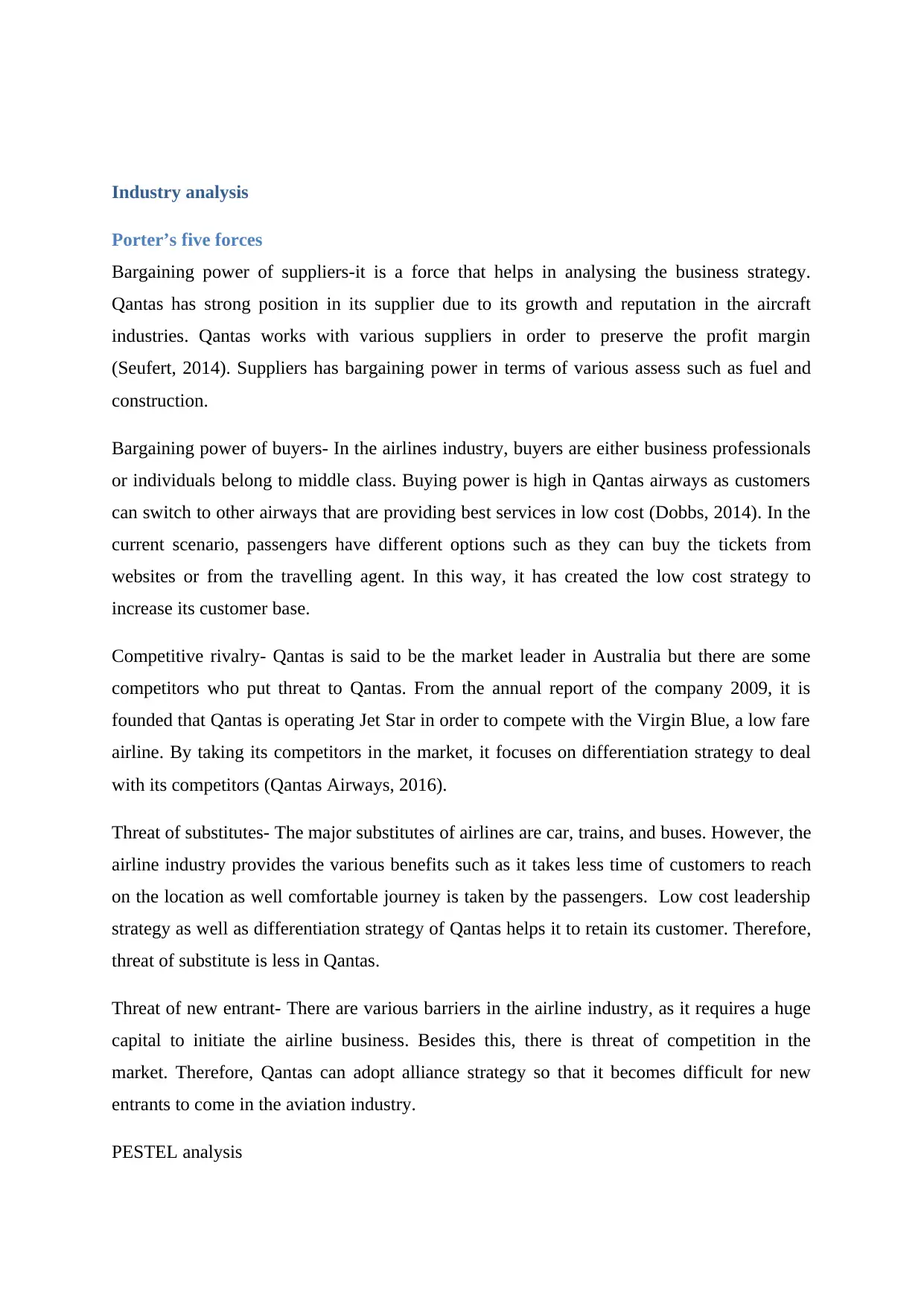
Industry analysis
Porter’s five forces
Bargaining power of suppliers-it is a force that helps in analysing the business strategy.
Qantas has strong position in its supplier due to its growth and reputation in the aircraft
industries. Qantas works with various suppliers in order to preserve the profit margin
(Seufert, 2014). Suppliers has bargaining power in terms of various assess such as fuel and
construction.
Bargaining power of buyers- In the airlines industry, buyers are either business professionals
or individuals belong to middle class. Buying power is high in Qantas airways as customers
can switch to other airways that are providing best services in low cost (Dobbs, 2014). In the
current scenario, passengers have different options such as they can buy the tickets from
websites or from the travelling agent. In this way, it has created the low cost strategy to
increase its customer base.
Competitive rivalry- Qantas is said to be the market leader in Australia but there are some
competitors who put threat to Qantas. From the annual report of the company 2009, it is
founded that Qantas is operating Jet Star in order to compete with the Virgin Blue, a low fare
airline. By taking its competitors in the market, it focuses on differentiation strategy to deal
with its competitors (Qantas Airways, 2016).
Threat of substitutes- The major substitutes of airlines are car, trains, and buses. However, the
airline industry provides the various benefits such as it takes less time of customers to reach
on the location as well comfortable journey is taken by the passengers. Low cost leadership
strategy as well as differentiation strategy of Qantas helps it to retain its customer. Therefore,
threat of substitute is less in Qantas.
Threat of new entrant- There are various barriers in the airline industry, as it requires a huge
capital to initiate the airline business. Besides this, there is threat of competition in the
market. Therefore, Qantas can adopt alliance strategy so that it becomes difficult for new
entrants to come in the aviation industry.
PESTEL analysis
Porter’s five forces
Bargaining power of suppliers-it is a force that helps in analysing the business strategy.
Qantas has strong position in its supplier due to its growth and reputation in the aircraft
industries. Qantas works with various suppliers in order to preserve the profit margin
(Seufert, 2014). Suppliers has bargaining power in terms of various assess such as fuel and
construction.
Bargaining power of buyers- In the airlines industry, buyers are either business professionals
or individuals belong to middle class. Buying power is high in Qantas airways as customers
can switch to other airways that are providing best services in low cost (Dobbs, 2014). In the
current scenario, passengers have different options such as they can buy the tickets from
websites or from the travelling agent. In this way, it has created the low cost strategy to
increase its customer base.
Competitive rivalry- Qantas is said to be the market leader in Australia but there are some
competitors who put threat to Qantas. From the annual report of the company 2009, it is
founded that Qantas is operating Jet Star in order to compete with the Virgin Blue, a low fare
airline. By taking its competitors in the market, it focuses on differentiation strategy to deal
with its competitors (Qantas Airways, 2016).
Threat of substitutes- The major substitutes of airlines are car, trains, and buses. However, the
airline industry provides the various benefits such as it takes less time of customers to reach
on the location as well comfortable journey is taken by the passengers. Low cost leadership
strategy as well as differentiation strategy of Qantas helps it to retain its customer. Therefore,
threat of substitute is less in Qantas.
Threat of new entrant- There are various barriers in the airline industry, as it requires a huge
capital to initiate the airline business. Besides this, there is threat of competition in the
market. Therefore, Qantas can adopt alliance strategy so that it becomes difficult for new
entrants to come in the aviation industry.
PESTEL analysis
Secure Best Marks with AI Grader
Need help grading? Try our AI Grader for instant feedback on your assignments.
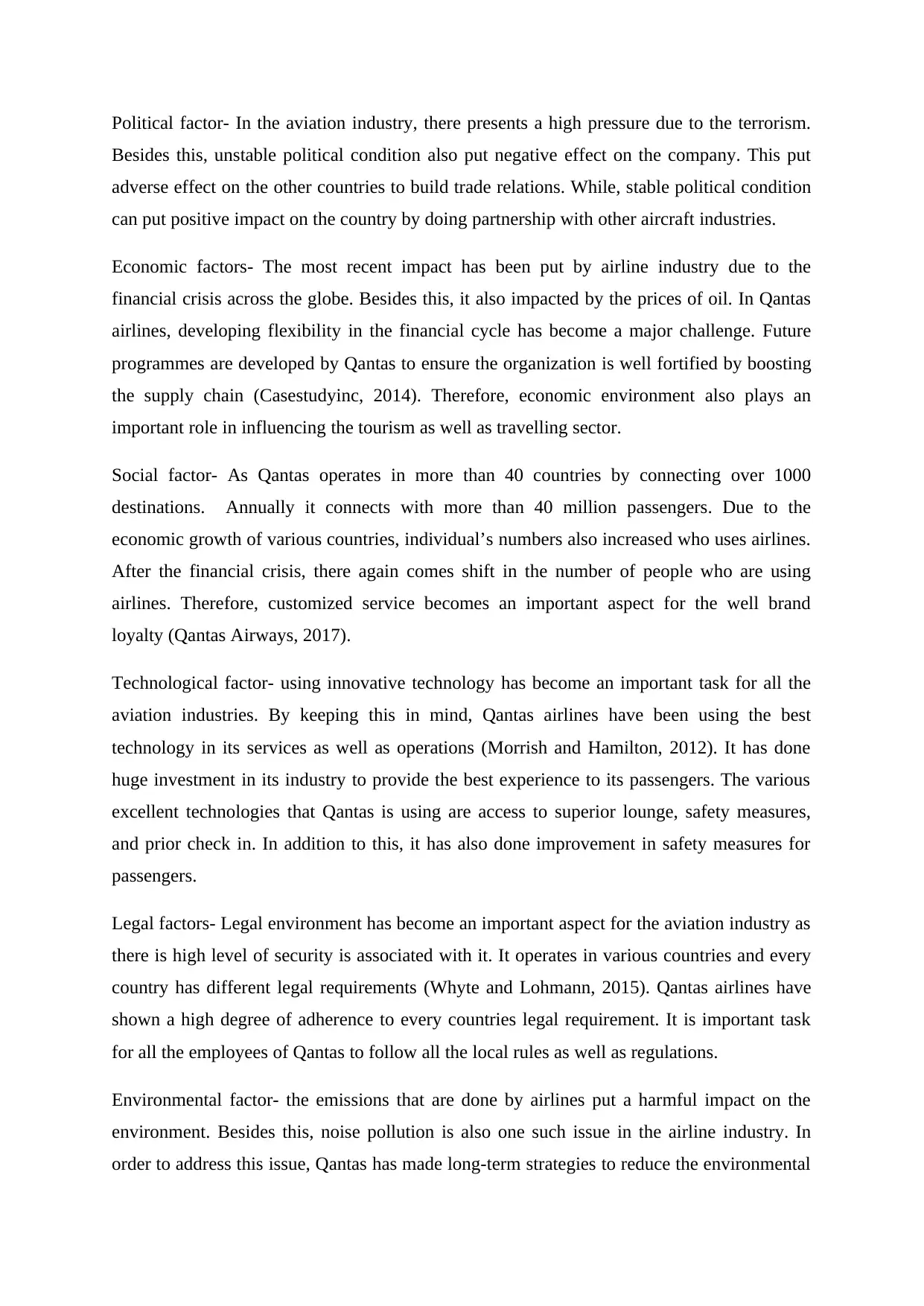
Political factor- In the aviation industry, there presents a high pressure due to the terrorism.
Besides this, unstable political condition also put negative effect on the company. This put
adverse effect on the other countries to build trade relations. While, stable political condition
can put positive impact on the country by doing partnership with other aircraft industries.
Economic factors- The most recent impact has been put by airline industry due to the
financial crisis across the globe. Besides this, it also impacted by the prices of oil. In Qantas
airlines, developing flexibility in the financial cycle has become a major challenge. Future
programmes are developed by Qantas to ensure the organization is well fortified by boosting
the supply chain (Casestudyinc, 2014). Therefore, economic environment also plays an
important role in influencing the tourism as well as travelling sector.
Social factor- As Qantas operates in more than 40 countries by connecting over 1000
destinations. Annually it connects with more than 40 million passengers. Due to the
economic growth of various countries, individual’s numbers also increased who uses airlines.
After the financial crisis, there again comes shift in the number of people who are using
airlines. Therefore, customized service becomes an important aspect for the well brand
loyalty (Qantas Airways, 2017).
Technological factor- using innovative technology has become an important task for all the
aviation industries. By keeping this in mind, Qantas airlines have been using the best
technology in its services as well as operations (Morrish and Hamilton, 2012). It has done
huge investment in its industry to provide the best experience to its passengers. The various
excellent technologies that Qantas is using are access to superior lounge, safety measures,
and prior check in. In addition to this, it has also done improvement in safety measures for
passengers.
Legal factors- Legal environment has become an important aspect for the aviation industry as
there is high level of security is associated with it. It operates in various countries and every
country has different legal requirements (Whyte and Lohmann, 2015). Qantas airlines have
shown a high degree of adherence to every countries legal requirement. It is important task
for all the employees of Qantas to follow all the local rules as well as regulations.
Environmental factor- the emissions that are done by airlines put a harmful impact on the
environment. Besides this, noise pollution is also one such issue in the airline industry. In
order to address this issue, Qantas has made long-term strategies to reduce the environmental
Besides this, unstable political condition also put negative effect on the company. This put
adverse effect on the other countries to build trade relations. While, stable political condition
can put positive impact on the country by doing partnership with other aircraft industries.
Economic factors- The most recent impact has been put by airline industry due to the
financial crisis across the globe. Besides this, it also impacted by the prices of oil. In Qantas
airlines, developing flexibility in the financial cycle has become a major challenge. Future
programmes are developed by Qantas to ensure the organization is well fortified by boosting
the supply chain (Casestudyinc, 2014). Therefore, economic environment also plays an
important role in influencing the tourism as well as travelling sector.
Social factor- As Qantas operates in more than 40 countries by connecting over 1000
destinations. Annually it connects with more than 40 million passengers. Due to the
economic growth of various countries, individual’s numbers also increased who uses airlines.
After the financial crisis, there again comes shift in the number of people who are using
airlines. Therefore, customized service becomes an important aspect for the well brand
loyalty (Qantas Airways, 2017).
Technological factor- using innovative technology has become an important task for all the
aviation industries. By keeping this in mind, Qantas airlines have been using the best
technology in its services as well as operations (Morrish and Hamilton, 2012). It has done
huge investment in its industry to provide the best experience to its passengers. The various
excellent technologies that Qantas is using are access to superior lounge, safety measures,
and prior check in. In addition to this, it has also done improvement in safety measures for
passengers.
Legal factors- Legal environment has become an important aspect for the aviation industry as
there is high level of security is associated with it. It operates in various countries and every
country has different legal requirements (Whyte and Lohmann, 2015). Qantas airlines have
shown a high degree of adherence to every countries legal requirement. It is important task
for all the employees of Qantas to follow all the local rules as well as regulations.
Environmental factor- the emissions that are done by airlines put a harmful impact on the
environment. Besides this, noise pollution is also one such issue in the airline industry. In
order to address this issue, Qantas has made long-term strategies to reduce the environmental
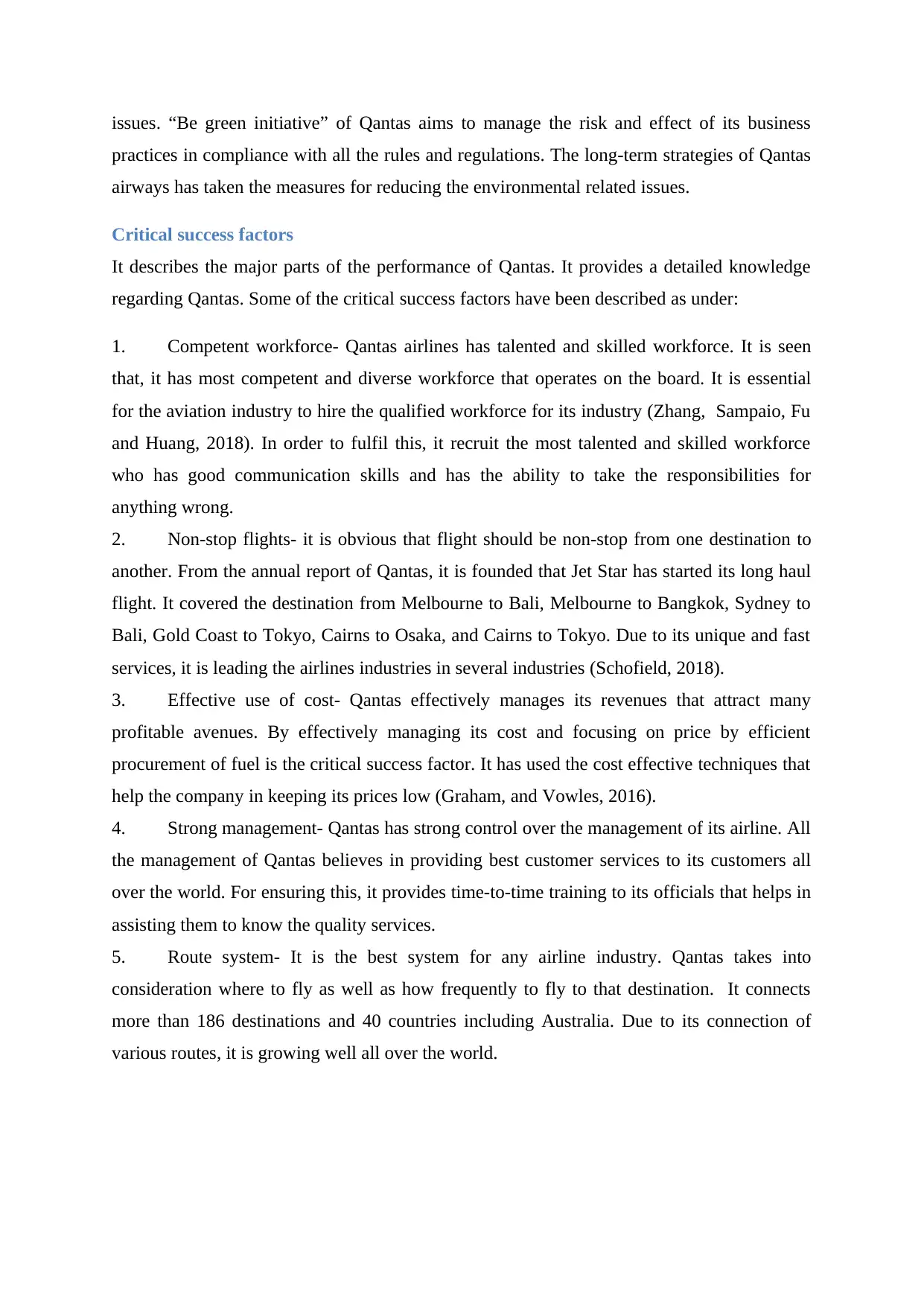
issues. “Be green initiative” of Qantas aims to manage the risk and effect of its business
practices in compliance with all the rules and regulations. The long-term strategies of Qantas
airways has taken the measures for reducing the environmental related issues.
Critical success factors
It describes the major parts of the performance of Qantas. It provides a detailed knowledge
regarding Qantas. Some of the critical success factors have been described as under:
1. Competent workforce- Qantas airlines has talented and skilled workforce. It is seen
that, it has most competent and diverse workforce that operates on the board. It is essential
for the aviation industry to hire the qualified workforce for its industry (Zhang, Sampaio, Fu
and Huang, 2018). In order to fulfil this, it recruit the most talented and skilled workforce
who has good communication skills and has the ability to take the responsibilities for
anything wrong.
2. Non-stop flights- it is obvious that flight should be non-stop from one destination to
another. From the annual report of Qantas, it is founded that Jet Star has started its long haul
flight. It covered the destination from Melbourne to Bali, Melbourne to Bangkok, Sydney to
Bali, Gold Coast to Tokyo, Cairns to Osaka, and Cairns to Tokyo. Due to its unique and fast
services, it is leading the airlines industries in several industries (Schofield, 2018).
3. Effective use of cost- Qantas effectively manages its revenues that attract many
profitable avenues. By effectively managing its cost and focusing on price by efficient
procurement of fuel is the critical success factor. It has used the cost effective techniques that
help the company in keeping its prices low (Graham, and Vowles, 2016).
4. Strong management- Qantas has strong control over the management of its airline. All
the management of Qantas believes in providing best customer services to its customers all
over the world. For ensuring this, it provides time-to-time training to its officials that helps in
assisting them to know the quality services.
5. Route system- It is the best system for any airline industry. Qantas takes into
consideration where to fly as well as how frequently to fly to that destination. It connects
more than 186 destinations and 40 countries including Australia. Due to its connection of
various routes, it is growing well all over the world.
practices in compliance with all the rules and regulations. The long-term strategies of Qantas
airways has taken the measures for reducing the environmental related issues.
Critical success factors
It describes the major parts of the performance of Qantas. It provides a detailed knowledge
regarding Qantas. Some of the critical success factors have been described as under:
1. Competent workforce- Qantas airlines has talented and skilled workforce. It is seen
that, it has most competent and diverse workforce that operates on the board. It is essential
for the aviation industry to hire the qualified workforce for its industry (Zhang, Sampaio, Fu
and Huang, 2018). In order to fulfil this, it recruit the most talented and skilled workforce
who has good communication skills and has the ability to take the responsibilities for
anything wrong.
2. Non-stop flights- it is obvious that flight should be non-stop from one destination to
another. From the annual report of Qantas, it is founded that Jet Star has started its long haul
flight. It covered the destination from Melbourne to Bali, Melbourne to Bangkok, Sydney to
Bali, Gold Coast to Tokyo, Cairns to Osaka, and Cairns to Tokyo. Due to its unique and fast
services, it is leading the airlines industries in several industries (Schofield, 2018).
3. Effective use of cost- Qantas effectively manages its revenues that attract many
profitable avenues. By effectively managing its cost and focusing on price by efficient
procurement of fuel is the critical success factor. It has used the cost effective techniques that
help the company in keeping its prices low (Graham, and Vowles, 2016).
4. Strong management- Qantas has strong control over the management of its airline. All
the management of Qantas believes in providing best customer services to its customers all
over the world. For ensuring this, it provides time-to-time training to its officials that helps in
assisting them to know the quality services.
5. Route system- It is the best system for any airline industry. Qantas takes into
consideration where to fly as well as how frequently to fly to that destination. It connects
more than 186 destinations and 40 countries including Australia. Due to its connection of
various routes, it is growing well all over the world.
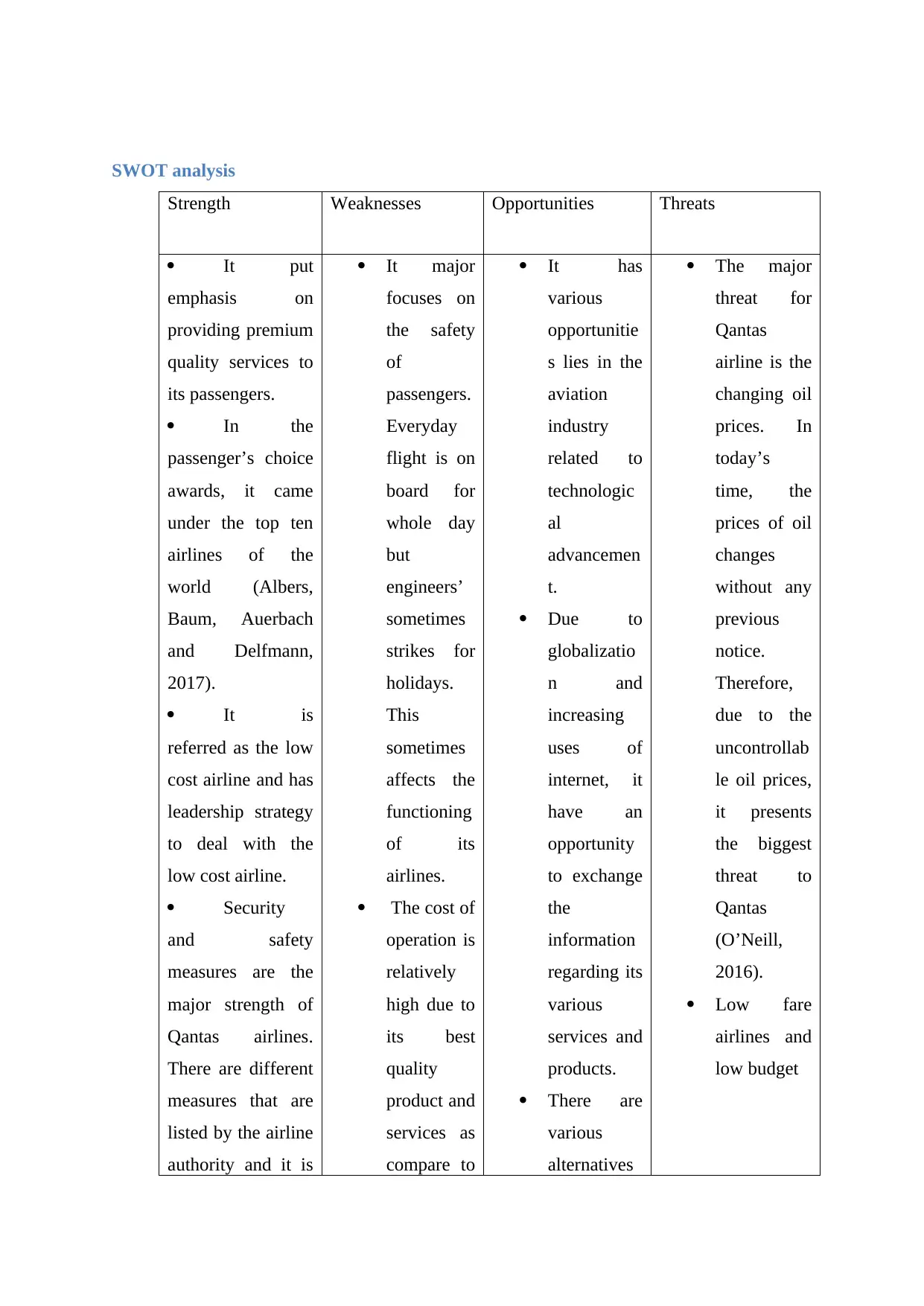
SWOT analysis
Strength Weaknesses Opportunities Threats
It put
emphasis on
providing premium
quality services to
its passengers.
In the
passenger’s choice
awards, it came
under the top ten
airlines of the
world (Albers,
Baum, Auerbach
and Delfmann,
2017).
It is
referred as the low
cost airline and has
leadership strategy
to deal with the
low cost airline.
Security
and safety
measures are the
major strength of
Qantas airlines.
There are different
measures that are
listed by the airline
authority and it is
It major
focuses on
the safety
of
passengers.
Everyday
flight is on
board for
whole day
but
engineers’
sometimes
strikes for
holidays.
This
sometimes
affects the
functioning
of its
airlines.
The cost of
operation is
relatively
high due to
its best
quality
product and
services as
compare to
It has
various
opportunitie
s lies in the
aviation
industry
related to
technologic
al
advancemen
t.
Due to
globalizatio
n and
increasing
uses of
internet, it
have an
opportunity
to exchange
the
information
regarding its
various
services and
products.
There are
various
alternatives
The major
threat for
Qantas
airline is the
changing oil
prices. In
today’s
time, the
prices of oil
changes
without any
previous
notice.
Therefore,
due to the
uncontrollab
le oil prices,
it presents
the biggest
threat to
Qantas
(O’Neill,
2016).
Low fare
airlines and
low budget
Strength Weaknesses Opportunities Threats
It put
emphasis on
providing premium
quality services to
its passengers.
In the
passenger’s choice
awards, it came
under the top ten
airlines of the
world (Albers,
Baum, Auerbach
and Delfmann,
2017).
It is
referred as the low
cost airline and has
leadership strategy
to deal with the
low cost airline.
Security
and safety
measures are the
major strength of
Qantas airlines.
There are different
measures that are
listed by the airline
authority and it is
It major
focuses on
the safety
of
passengers.
Everyday
flight is on
board for
whole day
but
engineers’
sometimes
strikes for
holidays.
This
sometimes
affects the
functioning
of its
airlines.
The cost of
operation is
relatively
high due to
its best
quality
product and
services as
compare to
It has
various
opportunitie
s lies in the
aviation
industry
related to
technologic
al
advancemen
t.
Due to
globalizatio
n and
increasing
uses of
internet, it
have an
opportunity
to exchange
the
information
regarding its
various
services and
products.
There are
various
alternatives
The major
threat for
Qantas
airline is the
changing oil
prices. In
today’s
time, the
prices of oil
changes
without any
previous
notice.
Therefore,
due to the
uncontrollab
le oil prices,
it presents
the biggest
threat to
Qantas
(O’Neill,
2016).
Low fare
airlines and
low budget
Paraphrase This Document
Need a fresh take? Get an instant paraphrase of this document with our AI Paraphraser
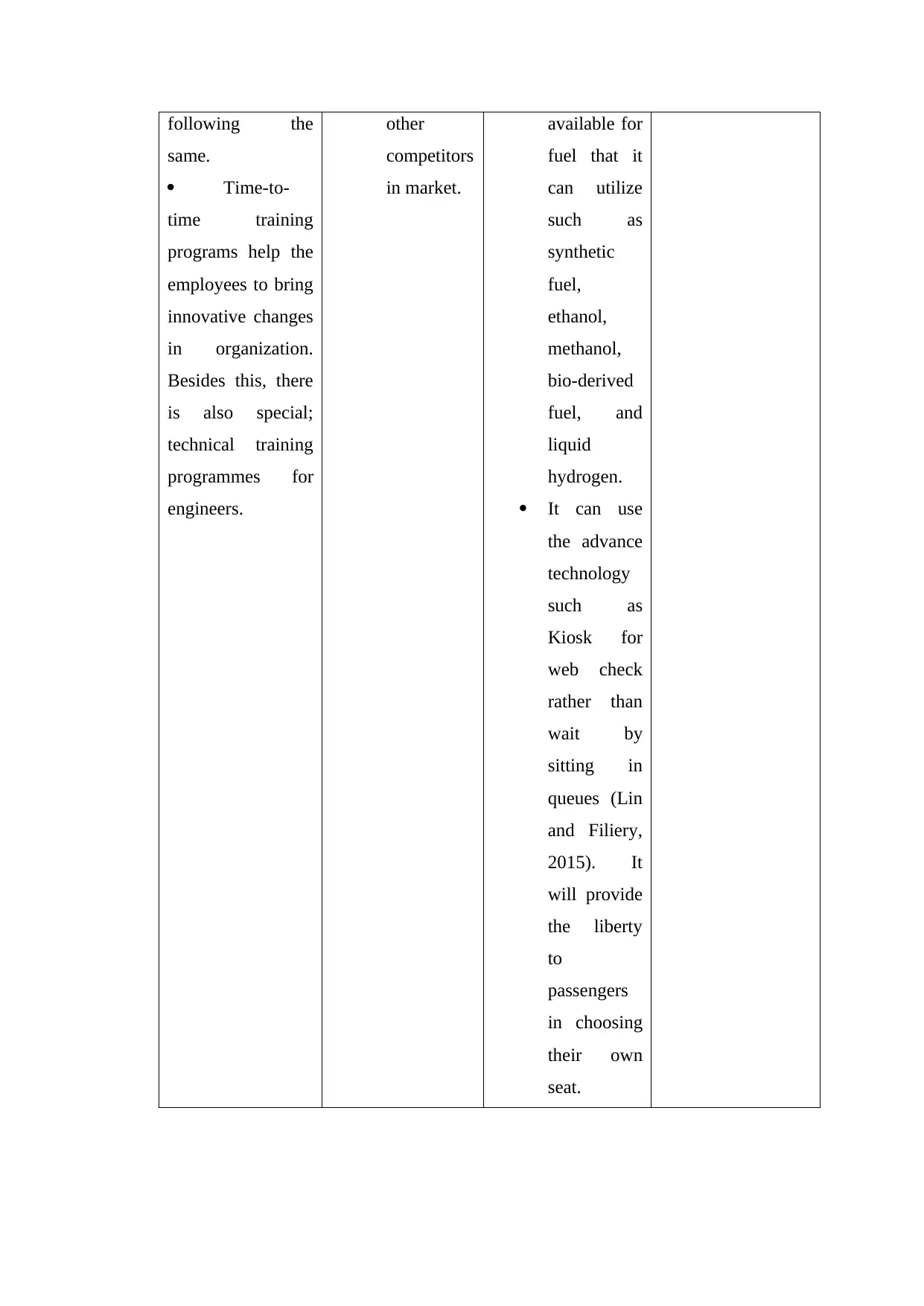
following the
same.
Time-to-
time training
programs help the
employees to bring
innovative changes
in organization.
Besides this, there
is also special;
technical training
programmes for
engineers.
other
competitors
in market.
available for
fuel that it
can utilize
such as
synthetic
fuel,
ethanol,
methanol,
bio-derived
fuel, and
liquid
hydrogen.
It can use
the advance
technology
such as
Kiosk for
web check
rather than
wait by
sitting in
queues (Lin
and Filiery,
2015). It
will provide
the liberty
to
passengers
in choosing
their own
seat.
same.
Time-to-
time training
programs help the
employees to bring
innovative changes
in organization.
Besides this, there
is also special;
technical training
programmes for
engineers.
other
competitors
in market.
available for
fuel that it
can utilize
such as
synthetic
fuel,
ethanol,
methanol,
bio-derived
fuel, and
liquid
hydrogen.
It can use
the advance
technology
such as
Kiosk for
web check
rather than
wait by
sitting in
queues (Lin
and Filiery,
2015). It
will provide
the liberty
to
passengers
in choosing
their own
seat.
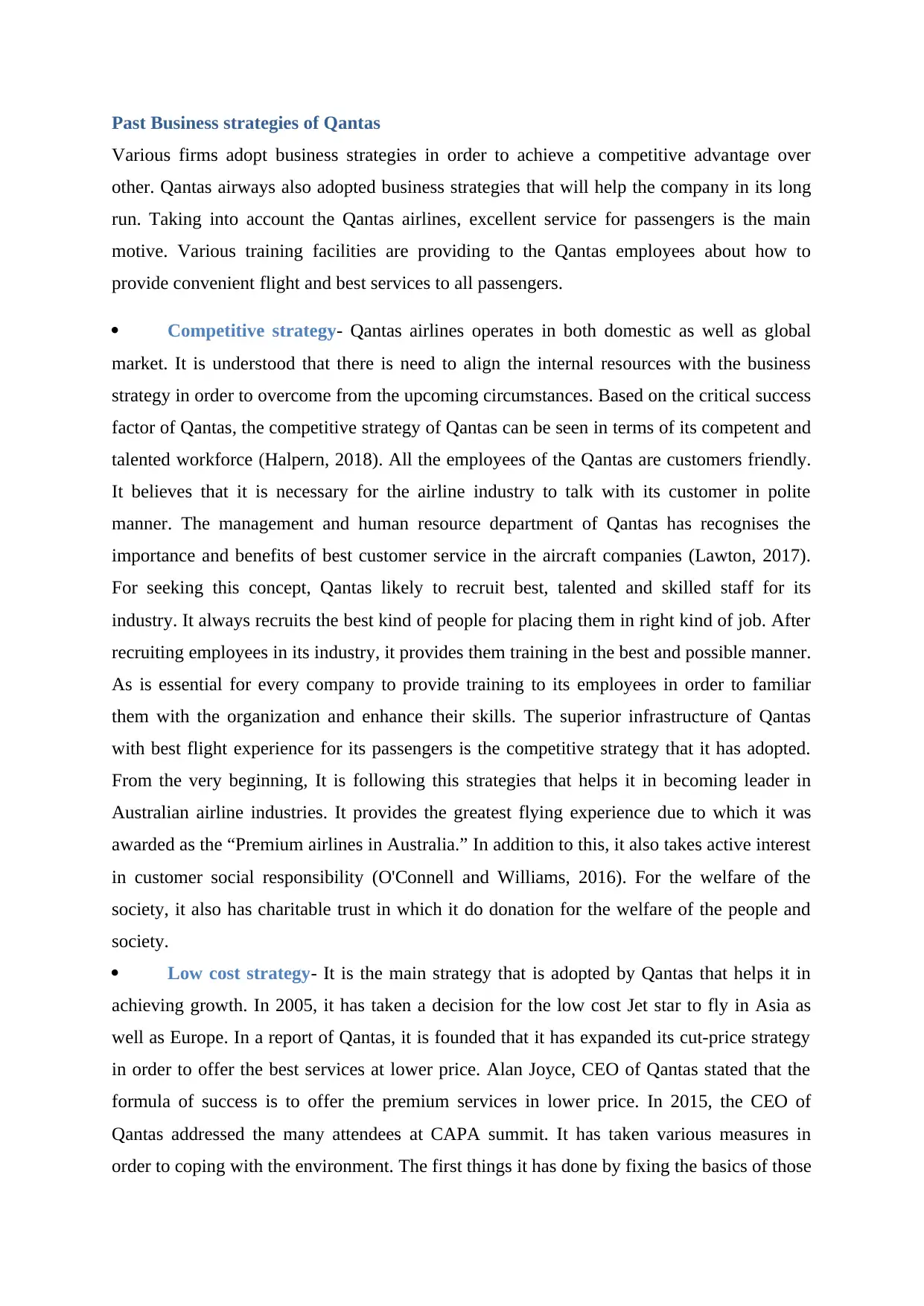
Past Business strategies of Qantas
Various firms adopt business strategies in order to achieve a competitive advantage over
other. Qantas airways also adopted business strategies that will help the company in its long
run. Taking into account the Qantas airlines, excellent service for passengers is the main
motive. Various training facilities are providing to the Qantas employees about how to
provide convenient flight and best services to all passengers.
Competitive strategy- Qantas airlines operates in both domestic as well as global
market. It is understood that there is need to align the internal resources with the business
strategy in order to overcome from the upcoming circumstances. Based on the critical success
factor of Qantas, the competitive strategy of Qantas can be seen in terms of its competent and
talented workforce (Halpern, 2018). All the employees of the Qantas are customers friendly.
It believes that it is necessary for the airline industry to talk with its customer in polite
manner. The management and human resource department of Qantas has recognises the
importance and benefits of best customer service in the aircraft companies (Lawton, 2017).
For seeking this concept, Qantas likely to recruit best, talented and skilled staff for its
industry. It always recruits the best kind of people for placing them in right kind of job. After
recruiting employees in its industry, it provides them training in the best and possible manner.
As is essential for every company to provide training to its employees in order to familiar
them with the organization and enhance their skills. The superior infrastructure of Qantas
with best flight experience for its passengers is the competitive strategy that it has adopted.
From the very beginning, It is following this strategies that helps it in becoming leader in
Australian airline industries. It provides the greatest flying experience due to which it was
awarded as the “Premium airlines in Australia.” In addition to this, it also takes active interest
in customer social responsibility (O'Connell and Williams, 2016). For the welfare of the
society, it also has charitable trust in which it do donation for the welfare of the people and
society.
Low cost strategy- It is the main strategy that is adopted by Qantas that helps it in
achieving growth. In 2005, it has taken a decision for the low cost Jet star to fly in Asia as
well as Europe. In a report of Qantas, it is founded that it has expanded its cut-price strategy
in order to offer the best services at lower price. Alan Joyce, CEO of Qantas stated that the
formula of success is to offer the premium services in lower price. In 2015, the CEO of
Qantas addressed the many attendees at CAPA summit. It has taken various measures in
order to coping with the environment. The first things it has done by fixing the basics of those
Various firms adopt business strategies in order to achieve a competitive advantage over
other. Qantas airways also adopted business strategies that will help the company in its long
run. Taking into account the Qantas airlines, excellent service for passengers is the main
motive. Various training facilities are providing to the Qantas employees about how to
provide convenient flight and best services to all passengers.
Competitive strategy- Qantas airlines operates in both domestic as well as global
market. It is understood that there is need to align the internal resources with the business
strategy in order to overcome from the upcoming circumstances. Based on the critical success
factor of Qantas, the competitive strategy of Qantas can be seen in terms of its competent and
talented workforce (Halpern, 2018). All the employees of the Qantas are customers friendly.
It believes that it is necessary for the airline industry to talk with its customer in polite
manner. The management and human resource department of Qantas has recognises the
importance and benefits of best customer service in the aircraft companies (Lawton, 2017).
For seeking this concept, Qantas likely to recruit best, talented and skilled staff for its
industry. It always recruits the best kind of people for placing them in right kind of job. After
recruiting employees in its industry, it provides them training in the best and possible manner.
As is essential for every company to provide training to its employees in order to familiar
them with the organization and enhance their skills. The superior infrastructure of Qantas
with best flight experience for its passengers is the competitive strategy that it has adopted.
From the very beginning, It is following this strategies that helps it in becoming leader in
Australian airline industries. It provides the greatest flying experience due to which it was
awarded as the “Premium airlines in Australia.” In addition to this, it also takes active interest
in customer social responsibility (O'Connell and Williams, 2016). For the welfare of the
society, it also has charitable trust in which it do donation for the welfare of the people and
society.
Low cost strategy- It is the main strategy that is adopted by Qantas that helps it in
achieving growth. In 2005, it has taken a decision for the low cost Jet star to fly in Asia as
well as Europe. In a report of Qantas, it is founded that it has expanded its cut-price strategy
in order to offer the best services at lower price. Alan Joyce, CEO of Qantas stated that the
formula of success is to offer the premium services in lower price. In 2015, the CEO of
Qantas addressed the many attendees at CAPA summit. It has taken various measures in
order to coping with the environment. The first things it has done by fixing the basics of those
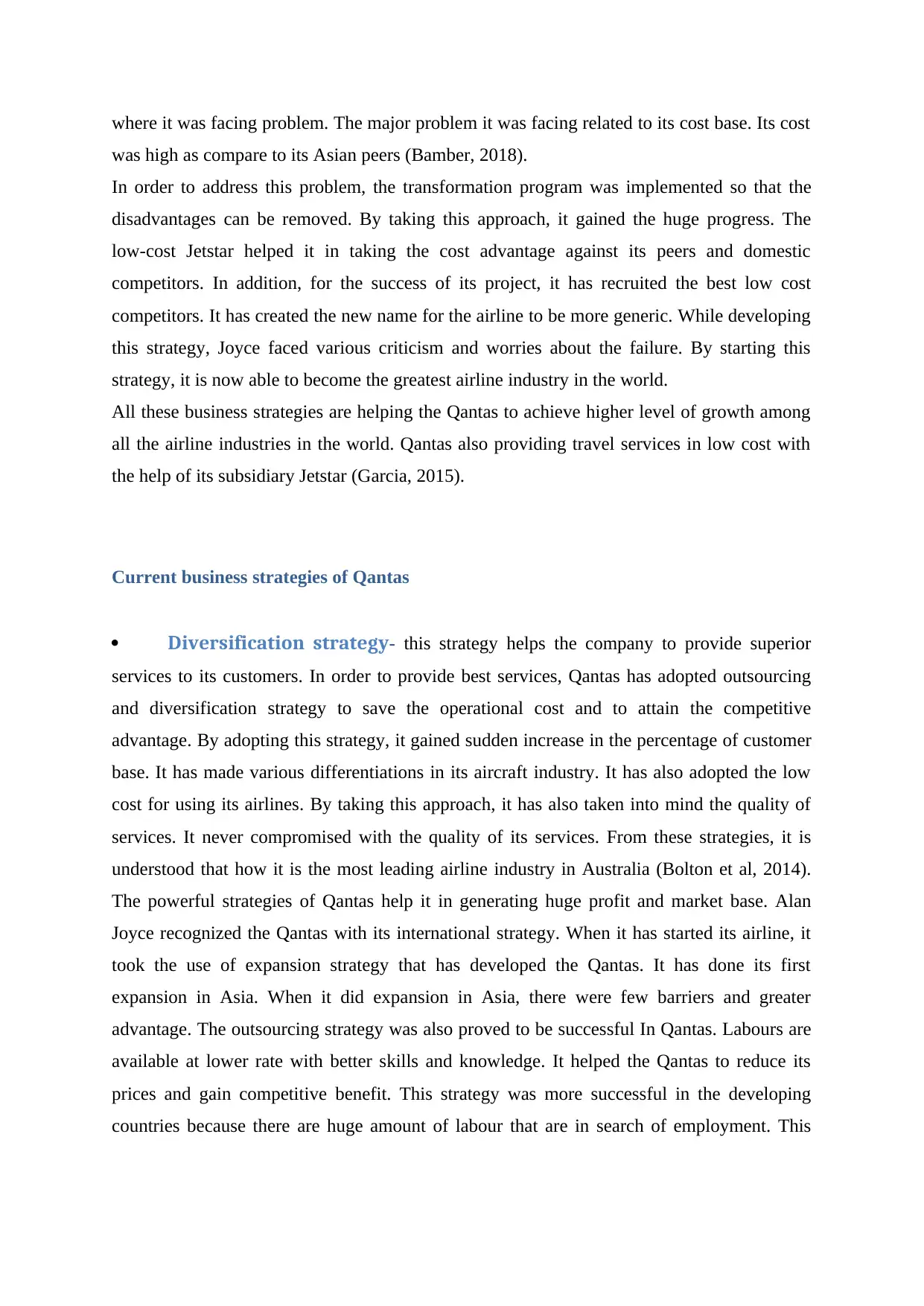
where it was facing problem. The major problem it was facing related to its cost base. Its cost
was high as compare to its Asian peers (Bamber, 2018).
In order to address this problem, the transformation program was implemented so that the
disadvantages can be removed. By taking this approach, it gained the huge progress. The
low-cost Jetstar helped it in taking the cost advantage against its peers and domestic
competitors. In addition, for the success of its project, it has recruited the best low cost
competitors. It has created the new name for the airline to be more generic. While developing
this strategy, Joyce faced various criticism and worries about the failure. By starting this
strategy, it is now able to become the greatest airline industry in the world.
All these business strategies are helping the Qantas to achieve higher level of growth among
all the airline industries in the world. Qantas also providing travel services in low cost with
the help of its subsidiary Jetstar (Garcia, 2015).
Current business strategies of Qantas
Diversification strategy- this strategy helps the company to provide superior
services to its customers. In order to provide best services, Qantas has adopted outsourcing
and diversification strategy to save the operational cost and to attain the competitive
advantage. By adopting this strategy, it gained sudden increase in the percentage of customer
base. It has made various differentiations in its aircraft industry. It has also adopted the low
cost for using its airlines. By taking this approach, it has also taken into mind the quality of
services. It never compromised with the quality of its services. From these strategies, it is
understood that how it is the most leading airline industry in Australia (Bolton et al, 2014).
The powerful strategies of Qantas help it in generating huge profit and market base. Alan
Joyce recognized the Qantas with its international strategy. When it has started its airline, it
took the use of expansion strategy that has developed the Qantas. It has done its first
expansion in Asia. When it did expansion in Asia, there were few barriers and greater
advantage. The outsourcing strategy was also proved to be successful In Qantas. Labours are
available at lower rate with better skills and knowledge. It helped the Qantas to reduce its
prices and gain competitive benefit. This strategy was more successful in the developing
countries because there are huge amount of labour that are in search of employment. This
was high as compare to its Asian peers (Bamber, 2018).
In order to address this problem, the transformation program was implemented so that the
disadvantages can be removed. By taking this approach, it gained the huge progress. The
low-cost Jetstar helped it in taking the cost advantage against its peers and domestic
competitors. In addition, for the success of its project, it has recruited the best low cost
competitors. It has created the new name for the airline to be more generic. While developing
this strategy, Joyce faced various criticism and worries about the failure. By starting this
strategy, it is now able to become the greatest airline industry in the world.
All these business strategies are helping the Qantas to achieve higher level of growth among
all the airline industries in the world. Qantas also providing travel services in low cost with
the help of its subsidiary Jetstar (Garcia, 2015).
Current business strategies of Qantas
Diversification strategy- this strategy helps the company to provide superior
services to its customers. In order to provide best services, Qantas has adopted outsourcing
and diversification strategy to save the operational cost and to attain the competitive
advantage. By adopting this strategy, it gained sudden increase in the percentage of customer
base. It has made various differentiations in its aircraft industry. It has also adopted the low
cost for using its airlines. By taking this approach, it has also taken into mind the quality of
services. It never compromised with the quality of its services. From these strategies, it is
understood that how it is the most leading airline industry in Australia (Bolton et al, 2014).
The powerful strategies of Qantas help it in generating huge profit and market base. Alan
Joyce recognized the Qantas with its international strategy. When it has started its airline, it
took the use of expansion strategy that has developed the Qantas. It has done its first
expansion in Asia. When it did expansion in Asia, there were few barriers and greater
advantage. The outsourcing strategy was also proved to be successful In Qantas. Labours are
available at lower rate with better skills and knowledge. It helped the Qantas to reduce its
prices and gain competitive benefit. This strategy was more successful in the developing
countries because there are huge amount of labour that are in search of employment. This
Secure Best Marks with AI Grader
Need help grading? Try our AI Grader for instant feedback on your assignments.
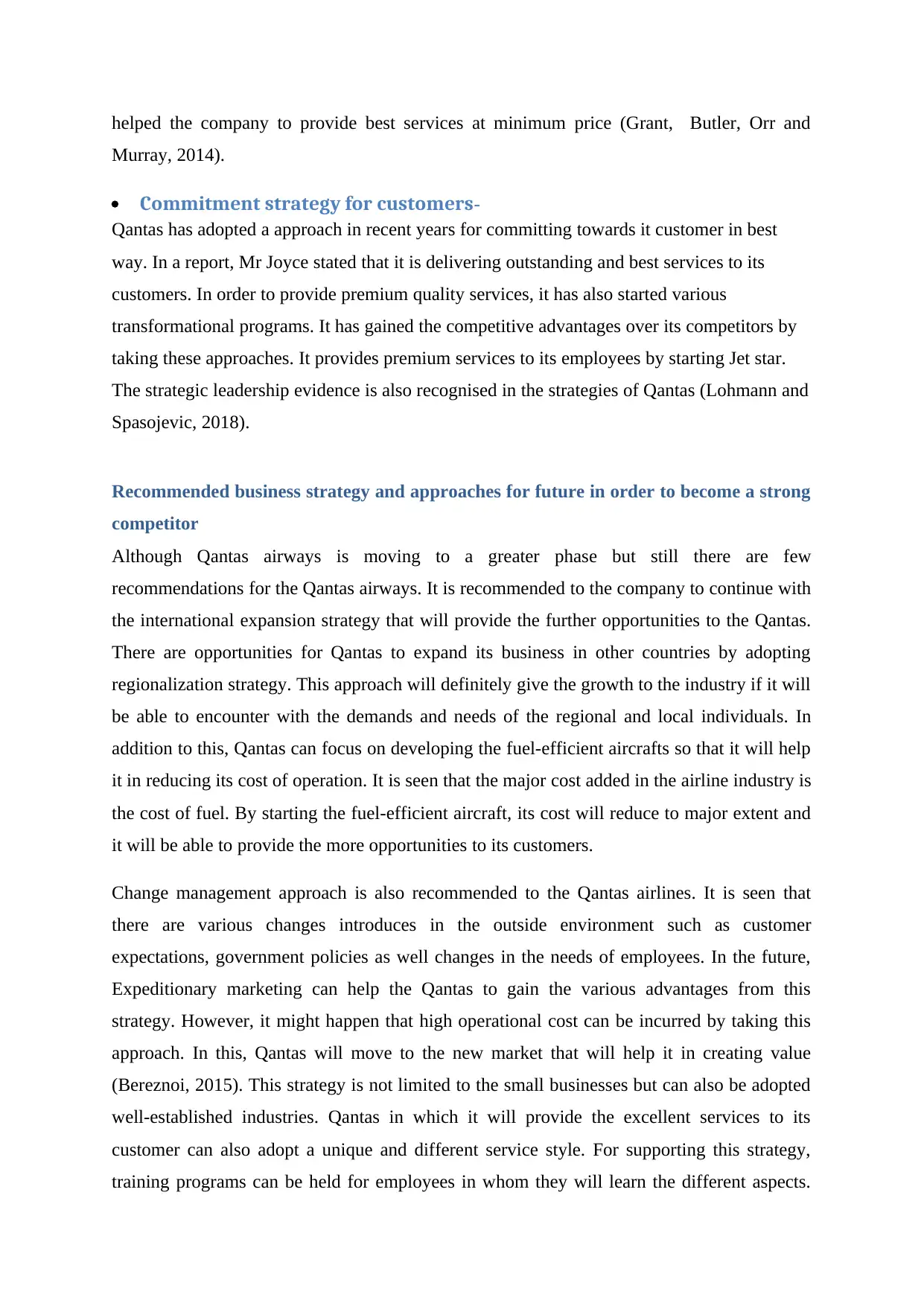
helped the company to provide best services at minimum price (Grant, Butler, Orr and
Murray, 2014).
Commitment strategy for customers-
Qantas has adopted a approach in recent years for committing towards it customer in best
way. In a report, Mr Joyce stated that it is delivering outstanding and best services to its
customers. In order to provide premium quality services, it has also started various
transformational programs. It has gained the competitive advantages over its competitors by
taking these approaches. It provides premium services to its employees by starting Jet star.
The strategic leadership evidence is also recognised in the strategies of Qantas (Lohmann and
Spasojevic, 2018).
Recommended business strategy and approaches for future in order to become a strong
competitor
Although Qantas airways is moving to a greater phase but still there are few
recommendations for the Qantas airways. It is recommended to the company to continue with
the international expansion strategy that will provide the further opportunities to the Qantas.
There are opportunities for Qantas to expand its business in other countries by adopting
regionalization strategy. This approach will definitely give the growth to the industry if it will
be able to encounter with the demands and needs of the regional and local individuals. In
addition to this, Qantas can focus on developing the fuel-efficient aircrafts so that it will help
it in reducing its cost of operation. It is seen that the major cost added in the airline industry is
the cost of fuel. By starting the fuel-efficient aircraft, its cost will reduce to major extent and
it will be able to provide the more opportunities to its customers.
Change management approach is also recommended to the Qantas airlines. It is seen that
there are various changes introduces in the outside environment such as customer
expectations, government policies as well changes in the needs of employees. In the future,
Expeditionary marketing can help the Qantas to gain the various advantages from this
strategy. However, it might happen that high operational cost can be incurred by taking this
approach. In this, Qantas will move to the new market that will help it in creating value
(Bereznoi, 2015). This strategy is not limited to the small businesses but can also be adopted
well-established industries. Qantas in which it will provide the excellent services to its
customer can also adopt a unique and different service style. For supporting this strategy,
training programs can be held for employees in whom they will learn the different aspects.
Murray, 2014).
Commitment strategy for customers-
Qantas has adopted a approach in recent years for committing towards it customer in best
way. In a report, Mr Joyce stated that it is delivering outstanding and best services to its
customers. In order to provide premium quality services, it has also started various
transformational programs. It has gained the competitive advantages over its competitors by
taking these approaches. It provides premium services to its employees by starting Jet star.
The strategic leadership evidence is also recognised in the strategies of Qantas (Lohmann and
Spasojevic, 2018).
Recommended business strategy and approaches for future in order to become a strong
competitor
Although Qantas airways is moving to a greater phase but still there are few
recommendations for the Qantas airways. It is recommended to the company to continue with
the international expansion strategy that will provide the further opportunities to the Qantas.
There are opportunities for Qantas to expand its business in other countries by adopting
regionalization strategy. This approach will definitely give the growth to the industry if it will
be able to encounter with the demands and needs of the regional and local individuals. In
addition to this, Qantas can focus on developing the fuel-efficient aircrafts so that it will help
it in reducing its cost of operation. It is seen that the major cost added in the airline industry is
the cost of fuel. By starting the fuel-efficient aircraft, its cost will reduce to major extent and
it will be able to provide the more opportunities to its customers.
Change management approach is also recommended to the Qantas airlines. It is seen that
there are various changes introduces in the outside environment such as customer
expectations, government policies as well changes in the needs of employees. In the future,
Expeditionary marketing can help the Qantas to gain the various advantages from this
strategy. However, it might happen that high operational cost can be incurred by taking this
approach. In this, Qantas will move to the new market that will help it in creating value
(Bereznoi, 2015). This strategy is not limited to the small businesses but can also be adopted
well-established industries. Qantas in which it will provide the excellent services to its
customer can also adopt a unique and different service style. For supporting this strategy,
training programs can be held for employees in whom they will learn the different aspects.
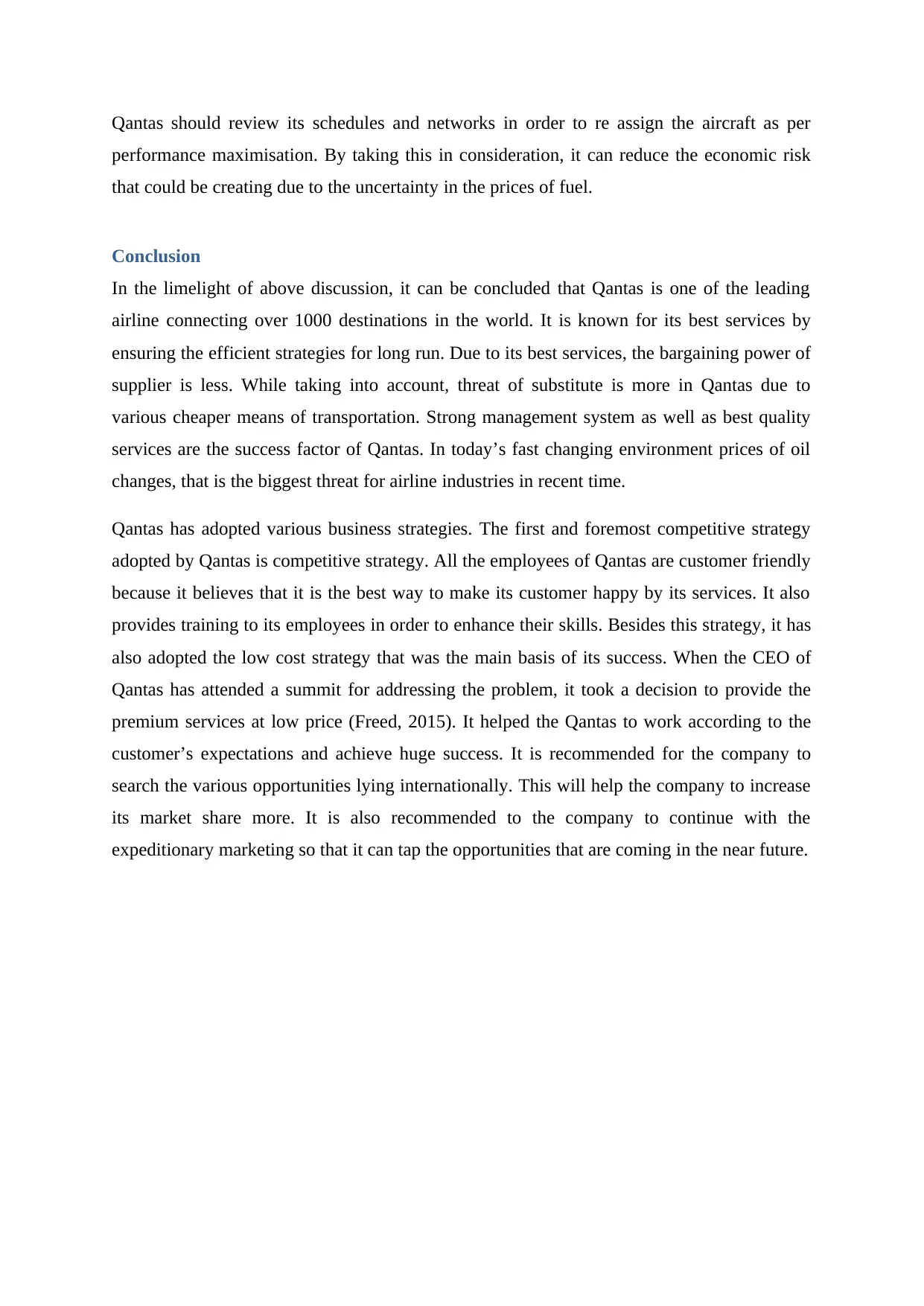
Qantas should review its schedules and networks in order to re assign the aircraft as per
performance maximisation. By taking this in consideration, it can reduce the economic risk
that could be creating due to the uncertainty in the prices of fuel.
Conclusion
In the limelight of above discussion, it can be concluded that Qantas is one of the leading
airline connecting over 1000 destinations in the world. It is known for its best services by
ensuring the efficient strategies for long run. Due to its best services, the bargaining power of
supplier is less. While taking into account, threat of substitute is more in Qantas due to
various cheaper means of transportation. Strong management system as well as best quality
services are the success factor of Qantas. In today’s fast changing environment prices of oil
changes, that is the biggest threat for airline industries in recent time.
Qantas has adopted various business strategies. The first and foremost competitive strategy
adopted by Qantas is competitive strategy. All the employees of Qantas are customer friendly
because it believes that it is the best way to make its customer happy by its services. It also
provides training to its employees in order to enhance their skills. Besides this strategy, it has
also adopted the low cost strategy that was the main basis of its success. When the CEO of
Qantas has attended a summit for addressing the problem, it took a decision to provide the
premium services at low price (Freed, 2015). It helped the Qantas to work according to the
customer’s expectations and achieve huge success. It is recommended for the company to
search the various opportunities lying internationally. This will help the company to increase
its market share more. It is also recommended to the company to continue with the
expeditionary marketing so that it can tap the opportunities that are coming in the near future.
performance maximisation. By taking this in consideration, it can reduce the economic risk
that could be creating due to the uncertainty in the prices of fuel.
Conclusion
In the limelight of above discussion, it can be concluded that Qantas is one of the leading
airline connecting over 1000 destinations in the world. It is known for its best services by
ensuring the efficient strategies for long run. Due to its best services, the bargaining power of
supplier is less. While taking into account, threat of substitute is more in Qantas due to
various cheaper means of transportation. Strong management system as well as best quality
services are the success factor of Qantas. In today’s fast changing environment prices of oil
changes, that is the biggest threat for airline industries in recent time.
Qantas has adopted various business strategies. The first and foremost competitive strategy
adopted by Qantas is competitive strategy. All the employees of Qantas are customer friendly
because it believes that it is the best way to make its customer happy by its services. It also
provides training to its employees in order to enhance their skills. Besides this strategy, it has
also adopted the low cost strategy that was the main basis of its success. When the CEO of
Qantas has attended a summit for addressing the problem, it took a decision to provide the
premium services at low price (Freed, 2015). It helped the Qantas to work according to the
customer’s expectations and achieve huge success. It is recommended for the company to
search the various opportunities lying internationally. This will help the company to increase
its market share more. It is also recommended to the company to continue with the
expeditionary marketing so that it can tap the opportunities that are coming in the near future.
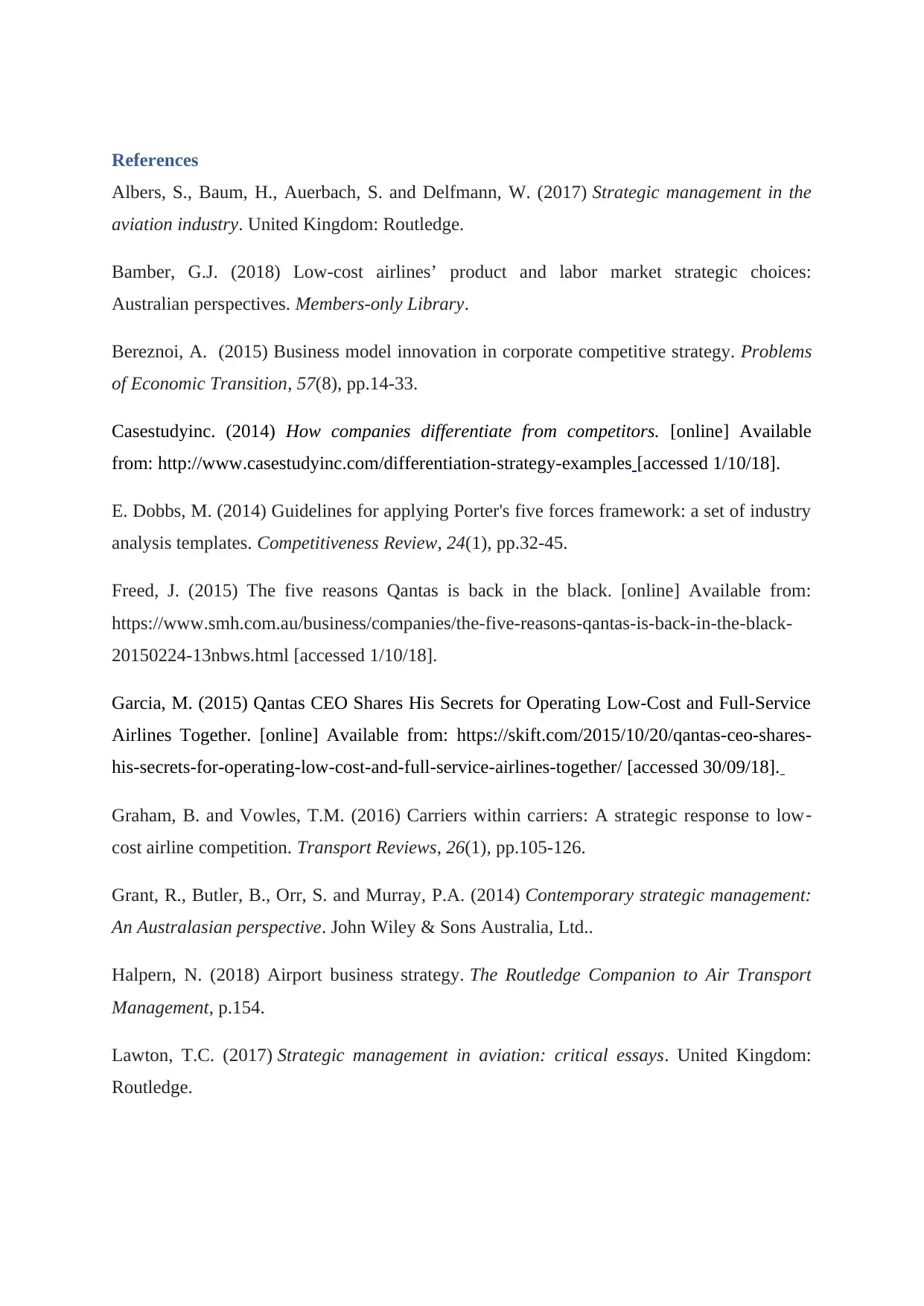
References
Albers, S., Baum, H., Auerbach, S. and Delfmann, W. (2017) Strategic management in the
aviation industry. United Kingdom: Routledge.
Bamber, G.J. (2018) Low-cost airlines’ product and labor market strategic choices:
Australian perspectives. Members-only Library.
Bereznoi, A. (2015) Business model innovation in corporate competitive strategy. Problems
of Economic Transition, 57(8), pp.14-33.
Casestudyinc. (2014) How companies differentiate from competitors. [online] Available
from: http://www.casestudyinc.com/differentiation-strategy-examples [accessed 1/10/18].
E. Dobbs, M. (2014) Guidelines for applying Porter's five forces framework: a set of industry
analysis templates. Competitiveness Review, 24(1), pp.32-45.
Freed, J. (2015) The five reasons Qantas is back in the black. [online] Available from:
https://www.smh.com.au/business/companies/the-five-reasons-qantas-is-back-in-the-black-
20150224-13nbws.html [accessed 1/10/18].
Garcia, M. (2015) Qantas CEO Shares His Secrets for Operating Low-Cost and Full-Service
Airlines Together. [online] Available from: https://skift.com/2015/10/20/qantas-ceo-shares-
his-secrets-for-operating-low-cost-and-full-service-airlines-together/ [accessed 30/09/18].
Graham, B. and Vowles, T.M. (2016) Carriers within carriers: A strategic response to low‐
cost airline competition. Transport Reviews, 26(1), pp.105-126.
Grant, R., Butler, B., Orr, S. and Murray, P.A. (2014) Contemporary strategic management:
An Australasian perspective. John Wiley & Sons Australia, Ltd..
Halpern, N. (2018) Airport business strategy. The Routledge Companion to Air Transport
Management, p.154.
Lawton, T.C. (2017) Strategic management in aviation: critical essays. United Kingdom:
Routledge.
Albers, S., Baum, H., Auerbach, S. and Delfmann, W. (2017) Strategic management in the
aviation industry. United Kingdom: Routledge.
Bamber, G.J. (2018) Low-cost airlines’ product and labor market strategic choices:
Australian perspectives. Members-only Library.
Bereznoi, A. (2015) Business model innovation in corporate competitive strategy. Problems
of Economic Transition, 57(8), pp.14-33.
Casestudyinc. (2014) How companies differentiate from competitors. [online] Available
from: http://www.casestudyinc.com/differentiation-strategy-examples [accessed 1/10/18].
E. Dobbs, M. (2014) Guidelines for applying Porter's five forces framework: a set of industry
analysis templates. Competitiveness Review, 24(1), pp.32-45.
Freed, J. (2015) The five reasons Qantas is back in the black. [online] Available from:
https://www.smh.com.au/business/companies/the-five-reasons-qantas-is-back-in-the-black-
20150224-13nbws.html [accessed 1/10/18].
Garcia, M. (2015) Qantas CEO Shares His Secrets for Operating Low-Cost and Full-Service
Airlines Together. [online] Available from: https://skift.com/2015/10/20/qantas-ceo-shares-
his-secrets-for-operating-low-cost-and-full-service-airlines-together/ [accessed 30/09/18].
Graham, B. and Vowles, T.M. (2016) Carriers within carriers: A strategic response to low‐
cost airline competition. Transport Reviews, 26(1), pp.105-126.
Grant, R., Butler, B., Orr, S. and Murray, P.A. (2014) Contemporary strategic management:
An Australasian perspective. John Wiley & Sons Australia, Ltd..
Halpern, N. (2018) Airport business strategy. The Routledge Companion to Air Transport
Management, p.154.
Lawton, T.C. (2017) Strategic management in aviation: critical essays. United Kingdom:
Routledge.
Paraphrase This Document
Need a fresh take? Get an instant paraphrase of this document with our AI Paraphraser
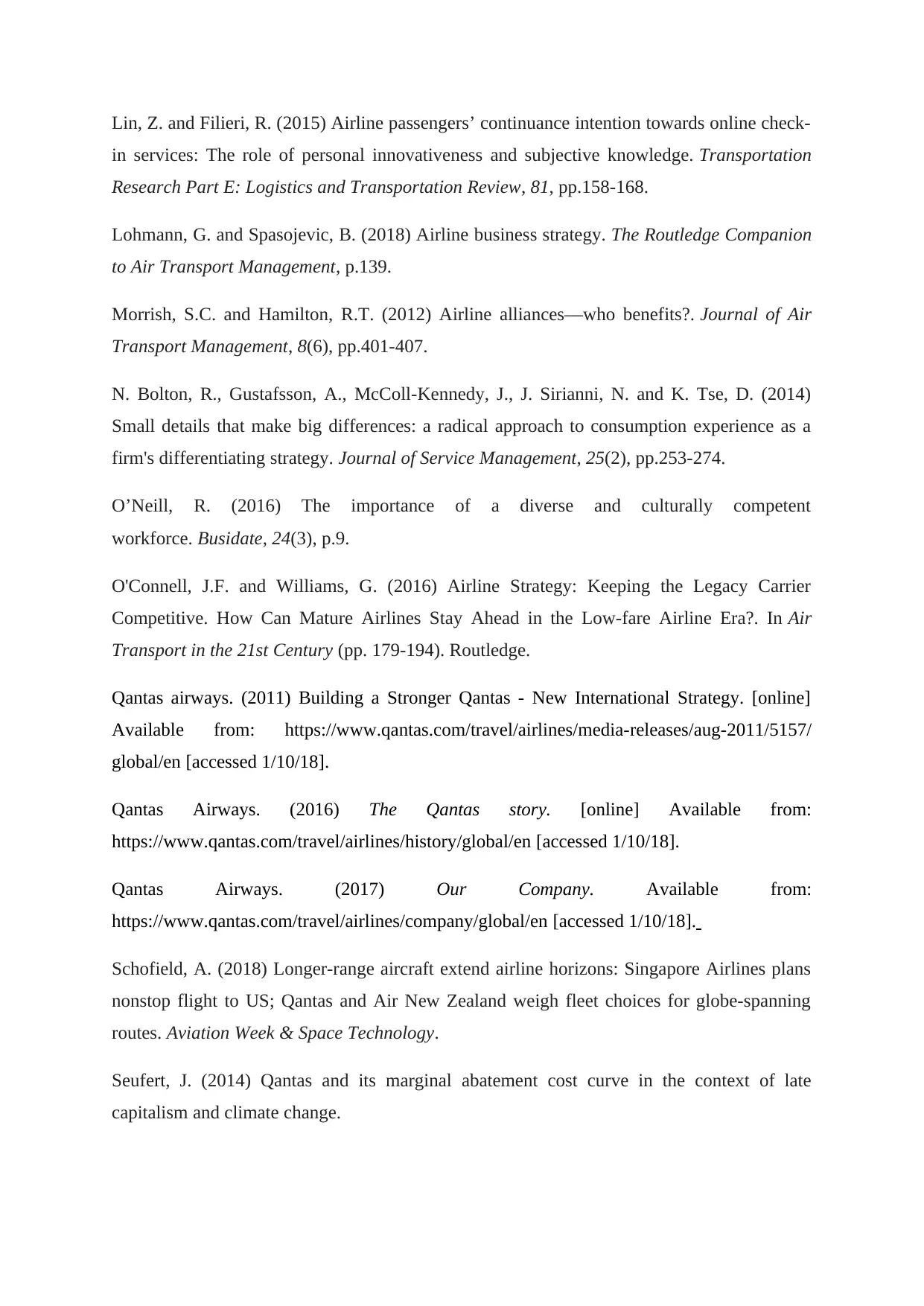
Lin, Z. and Filieri, R. (2015) Airline passengers’ continuance intention towards online check-
in services: The role of personal innovativeness and subjective knowledge. Transportation
Research Part E: Logistics and Transportation Review, 81, pp.158-168.
Lohmann, G. and Spasojevic, B. (2018) Airline business strategy. The Routledge Companion
to Air Transport Management, p.139.
Morrish, S.C. and Hamilton, R.T. (2012) Airline alliances—who benefits?. Journal of Air
Transport Management, 8(6), pp.401-407.
N. Bolton, R., Gustafsson, A., McColl-Kennedy, J., J. Sirianni, N. and K. Tse, D. (2014)
Small details that make big differences: a radical approach to consumption experience as a
firm's differentiating strategy. Journal of Service Management, 25(2), pp.253-274.
O’Neill, R. (2016) The importance of a diverse and culturally competent
workforce. Busidate, 24(3), p.9.
O'Connell, J.F. and Williams, G. (2016) Airline Strategy: Keeping the Legacy Carrier
Competitive. How Can Mature Airlines Stay Ahead in the Low-fare Airline Era?. In Air
Transport in the 21st Century (pp. 179-194). Routledge.
Qantas airways. (2011) Building a Stronger Qantas - New International Strategy. [online]
Available from: https://www.qantas.com/travel/airlines/media-releases/aug-2011/5157/
global/en [accessed 1/10/18].
Qantas Airways. (2016) The Qantas story. [online] Available from:
https://www.qantas.com/travel/airlines/history/global/en [accessed 1/10/18].
Qantas Airways. (2017) Our Company. Available from:
https://www.qantas.com/travel/airlines/company/global/en [accessed 1/10/18].
Schofield, A. (2018) Longer-range aircraft extend airline horizons: Singapore Airlines plans
nonstop flight to US; Qantas and Air New Zealand weigh fleet choices for globe-spanning
routes. Aviation Week & Space Technology.
Seufert, J. (2014) Qantas and its marginal abatement cost curve in the context of late
capitalism and climate change.
in services: The role of personal innovativeness and subjective knowledge. Transportation
Research Part E: Logistics and Transportation Review, 81, pp.158-168.
Lohmann, G. and Spasojevic, B. (2018) Airline business strategy. The Routledge Companion
to Air Transport Management, p.139.
Morrish, S.C. and Hamilton, R.T. (2012) Airline alliances—who benefits?. Journal of Air
Transport Management, 8(6), pp.401-407.
N. Bolton, R., Gustafsson, A., McColl-Kennedy, J., J. Sirianni, N. and K. Tse, D. (2014)
Small details that make big differences: a radical approach to consumption experience as a
firm's differentiating strategy. Journal of Service Management, 25(2), pp.253-274.
O’Neill, R. (2016) The importance of a diverse and culturally competent
workforce. Busidate, 24(3), p.9.
O'Connell, J.F. and Williams, G. (2016) Airline Strategy: Keeping the Legacy Carrier
Competitive. How Can Mature Airlines Stay Ahead in the Low-fare Airline Era?. In Air
Transport in the 21st Century (pp. 179-194). Routledge.
Qantas airways. (2011) Building a Stronger Qantas - New International Strategy. [online]
Available from: https://www.qantas.com/travel/airlines/media-releases/aug-2011/5157/
global/en [accessed 1/10/18].
Qantas Airways. (2016) The Qantas story. [online] Available from:
https://www.qantas.com/travel/airlines/history/global/en [accessed 1/10/18].
Qantas Airways. (2017) Our Company. Available from:
https://www.qantas.com/travel/airlines/company/global/en [accessed 1/10/18].
Schofield, A. (2018) Longer-range aircraft extend airline horizons: Singapore Airlines plans
nonstop flight to US; Qantas and Air New Zealand weigh fleet choices for globe-spanning
routes. Aviation Week & Space Technology.
Seufert, J. (2014) Qantas and its marginal abatement cost curve in the context of late
capitalism and climate change.
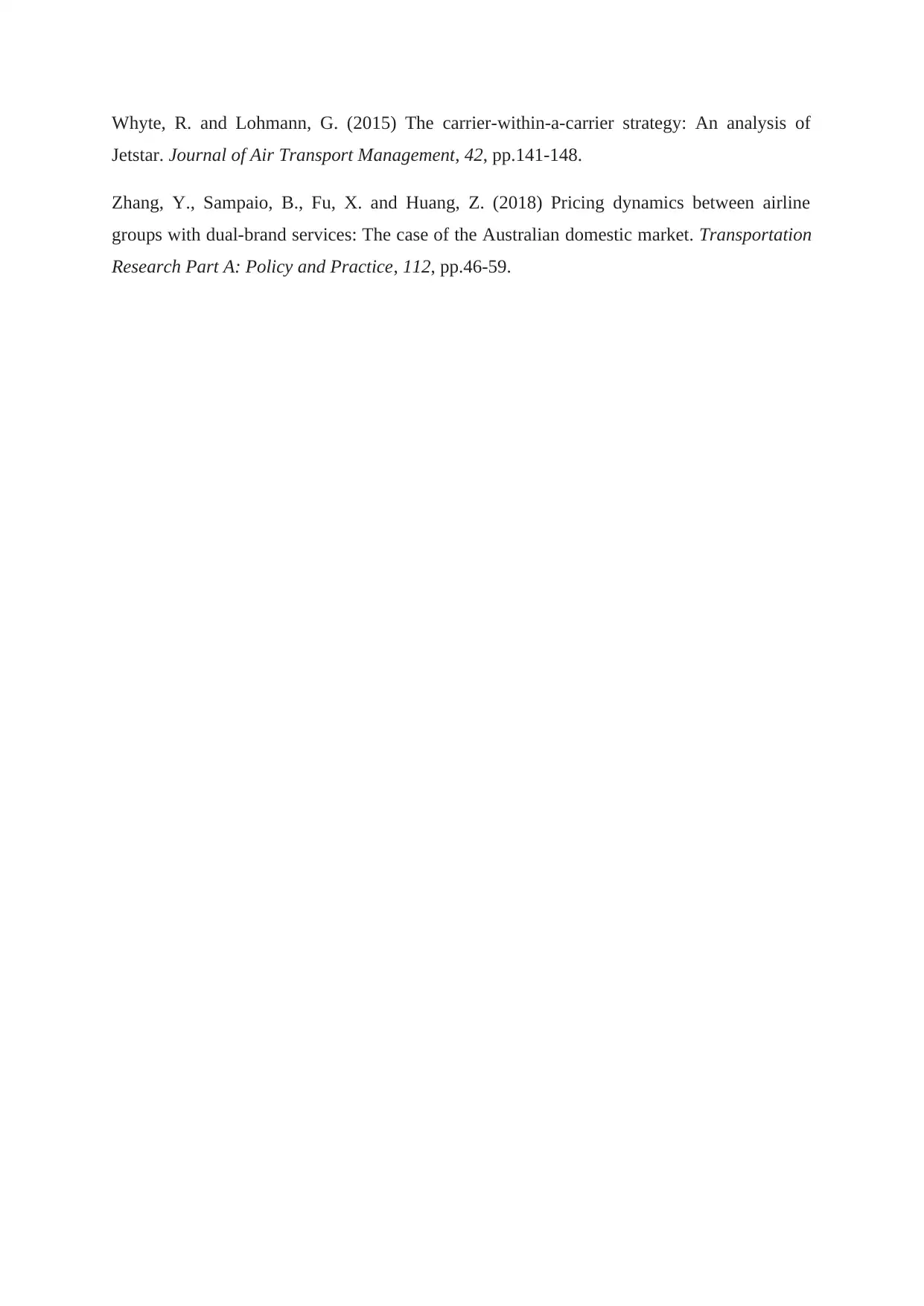
Whyte, R. and Lohmann, G. (2015) The carrier-within-a-carrier strategy: An analysis of
Jetstar. Journal of Air Transport Management, 42, pp.141-148.
Zhang, Y., Sampaio, B., Fu, X. and Huang, Z. (2018) Pricing dynamics between airline
groups with dual-brand services: The case of the Australian domestic market. Transportation
Research Part A: Policy and Practice, 112, pp.46-59.
Jetstar. Journal of Air Transport Management, 42, pp.141-148.
Zhang, Y., Sampaio, B., Fu, X. and Huang, Z. (2018) Pricing dynamics between airline
groups with dual-brand services: The case of the Australian domestic market. Transportation
Research Part A: Policy and Practice, 112, pp.46-59.
1 out of 15
Related Documents
Your All-in-One AI-Powered Toolkit for Academic Success.
+13062052269
info@desklib.com
Available 24*7 on WhatsApp / Email
![[object Object]](/_next/static/media/star-bottom.7253800d.svg)
Unlock your academic potential
© 2024 | Zucol Services PVT LTD | All rights reserved.





